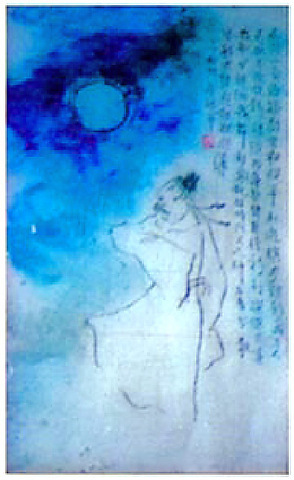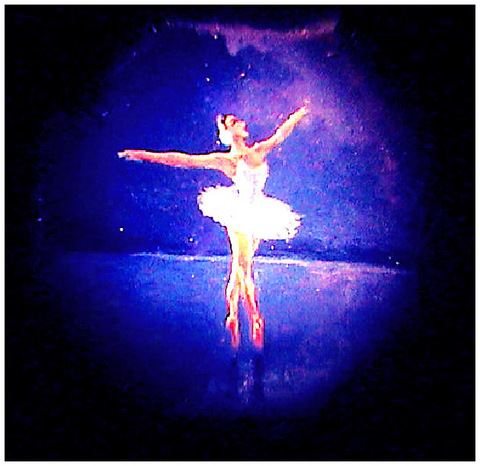I've never looked at Jin's micro-paintings or micro-carvings in person, and even if I had, I wouldn't have been able to see them -- not without a microscope. Even his biggest micro-painting, a group of portraits of the 42 US presidents on a single human hair, is less than 6mm long.
The Portraits of 42 American Presidents was completed last year in New York and holds the world record for most portraits in the smallest area. Somehow, Jin managed to give each president a vivid expression in a face with a diameter less than 0.4mm. Each face is distinct and recognizable.

Jin has created over 100 micro-paintings and carvings on different-colored hair, ivory and diamonds, and his works extend the traditional Chinese art of engraving and miniscule calligraphy.

PHOTOS COURTESY OF ARTIST:
In an e-mail interview, Jin explained that micro-painting has a long history in China and was done in pictographs on animal bones and tortoise shells. Jin called these Shang Dynasty inscriptions "the earliest mature writing" in China.
This writing, Jin said, was meant to evoke or explain the divine. As most people were illiterate, writing was of little help to the majority. In fact, it was the mystery of the inaccessible language that evoked the divine.
Today, micro-art creates hidden worlds similar to how carved pictographs created hidden worlds to populations of illiterates.
Jin has carved Tang Dynasty poems onto human hair, and his 1986 work Li Bai includes a Li Bai poem, beside a portrait of the poet in a white cloak under the moon -- all in a 3mm by 5.5mm area. Pine Trees in a Cloudy Valley (1985, 2x7.5mm), The Great Wall (1988, 3.5x6mm) and Flying Cloud (1986, 3x5.5mm) extend the Chinese landscape tradition, while Red Plum (1986, 3x6mm) is comparatively sparse and manages to contrast bright red petals on an ivory background through carving and painting.
Jin has extended traditional techniques of micro-carving and painting, too. He perfected a method called pomo in which minute amounts of ink are splashed onto the surface of ivory, usually about the size of a rice grain. Jin also uses more traditional tools, such as little brushes, inks and oils to paint.
Micro-painting is usually the medium he uses for his pop culture and Western-themed works, and he has also created micro-paintings of Asian and Middle Eastern heads of state. Elegant is a portrait on the width of a black hair and resembles Marilyn Monroe. Charlie Chaplain is about the same size and is painted on a white hair.
In the US and Europe, it's micro-painting, not micro-carving, that has found interest and applicability beyond pop culture icon renditions and pictures of president.
Micro-painting caught some attention during the West's modernist period, when American and European artists began to think of Asian art as something that could be applied to Western practice, not simply as something to gaze at with Orientalist thinking. Max Ernst's Micro-painting, at the Museum of Modern Art in New York is an example.
Micro-painting has also been practically applied in the area of making toys, trinkets, jewelry, models and game-pieces in the West, but China has been the hub of producing the items that are micro-painted and sent to the shelves of Western stores.
At the European company that produces Kinder Surprises -- tiny figures inside Easter eggs -- robots have taken over the painting of 23 million tiny figures, whose faces and details used to be painted by Chinese laborers. The robots are faster and paint with an accuracy within .01mm.
Micro-painting and micro-carving are still alive, well and centered in China, despite robotic competition. Jin separates his time between China and New York.
The world record for most characters in a micro-carving is held by Chinese artist?Xu Tonghai for, Selected Works of Mao Zedong, which includes 10,720,000 characters.

US President Donald Trump may have hoped for an impromptu talk with his old friend Kim Jong-un during a recent trip to Asia, but analysts say the increasingly emboldened North Korean despot had few good reasons to join the photo-op. Trump sent repeated overtures to Kim during his barnstorming tour of Asia, saying he was “100 percent” open to a meeting and even bucking decades of US policy by conceding that North Korea was “sort of a nuclear power.” But Pyongyang kept mum on the invitation, instead firing off missiles and sending its foreign minister to Russia and Belarus, with whom it

When Taiwan was battered by storms this summer, the only crumb of comfort I could take was knowing that some advice I’d drafted several weeks earlier had been correct. Regarding the Southern Cross-Island Highway (南橫公路), a spectacular high-elevation route connecting Taiwan’s southwest with the country’s southeast, I’d written: “The precarious existence of this road cannot be overstated; those hoping to drive or ride all the way across should have a backup plan.” As this article was going to press, the middle section of the highway, between Meishankou (梅山口) in Kaohsiung and Siangyang (向陽) in Taitung County, was still closed to outsiders

Many people noticed the flood of pro-China propaganda across a number of venues in recent weeks that looks like a coordinated assault on US Taiwan policy. It does look like an effort intended to influence the US before the meeting between US President Donald Trump and Chinese dictator Xi Jinping (習近平) over the weekend. Jennifer Kavanagh’s piece in the New York Times in September appears to be the opening strike of the current campaign. She followed up last week in the Lowy Interpreter, blaming the US for causing the PRC to escalate in the Philippines and Taiwan, saying that as

The Chinese Communist Party (CCP) has a dystopian, radical and dangerous conception of itself. Few are aware of this very fundamental difference between how they view power and how the rest of the world does. Even those of us who have lived in China sometimes fall back into the trap of viewing it through the lens of the power relationships common throughout the rest of the world, instead of understanding the CCP as it conceives of itself. Broadly speaking, the concepts of the people, race, culture, civilization, nation, government and religion are separate, though often overlapping and intertwined. A government